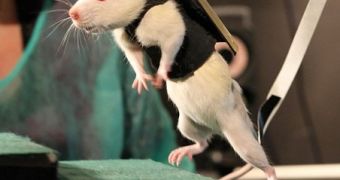While some researchers are busy getting ready to perform a state-of-the-art bionic hand transplant, other scientists are about to debut a series of human clinical trials meant to test the efficiency of a groundbreaking method of treating paralysis.
The paralysis treatment set to be tested on human patients in just a few months has made it possible for mice suffering with the same condition to regain their ability to walk, climb stairs and even run.
By the looks of it, the treatment has proved this successful in terms of treating paralysis in laboratory mice because of its using a combination of drugs and electrical impulses.
The researchers working on this project explain that, when administered simultaneously, the drug cocktail and the electrical impulses allowed the mice taken into consideration for this study to regrow the nerves linking their spinal cord to their brain.
Apparently, this translated into their getting back their ability to move their limbs. According to Daily Mail, it only took about two week for the mice to switch from not being able to move to being able to perform all said tasks.
In the aftermath of these laboratory-based experiments on mice and their proving to be nothing if not successful, the scientists are getting ready to test this technology on five human patients.
The patients selected for this clinical trial are not completely paralyzed. Thus, they are only suffering with limited leg movement.
Should these human patients respond well to this new paralysis treatment, the scientists hope that, within two years' time, they will be able to attempt helping people who have been immobile for periods of up to two years.
“We already have preliminary data from the rats with these clinically relevant lesions is that a number of them would recover at the end of the training and could walk without any help. It depends on the severity of the damage,” Professor Gregoirse Courtine said.
On the other hand, researcher Dan Burden wished to make it quite clear that, “We are a long way off anything that would resemble a cure in humans, but this is a first step which might well lead to new treatments which could make the future of people with spinal cord injuries seem brighter.”
This clinical trial involving five human patients with limited mobility is to be conducted at the Lausanne University Hospital in Switzerland.

 14 DAY TRIAL //
14 DAY TRIAL //